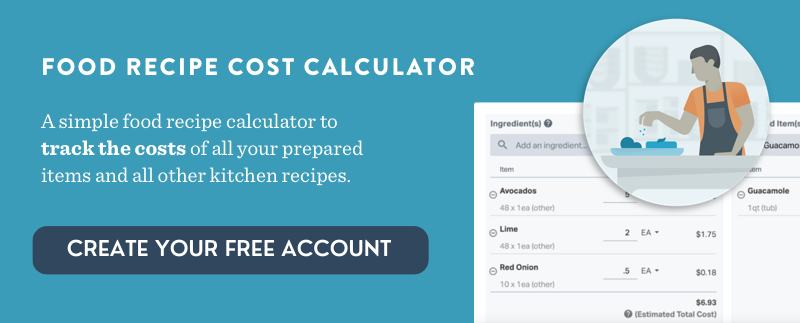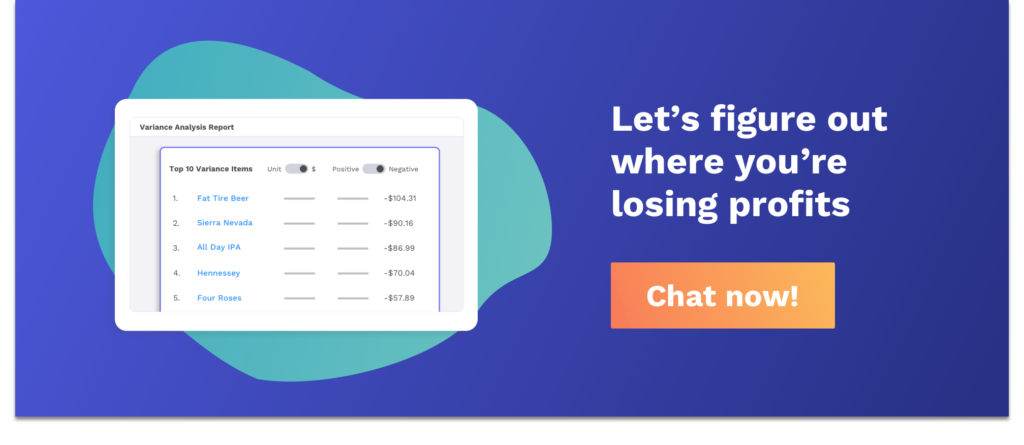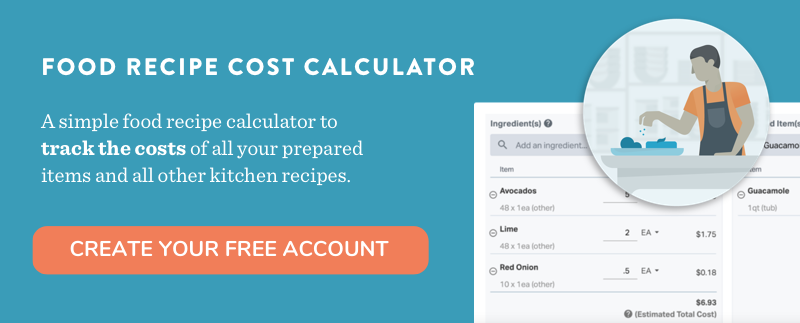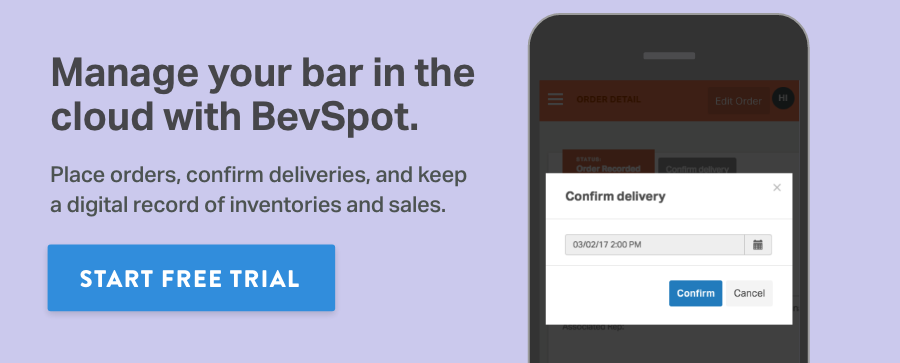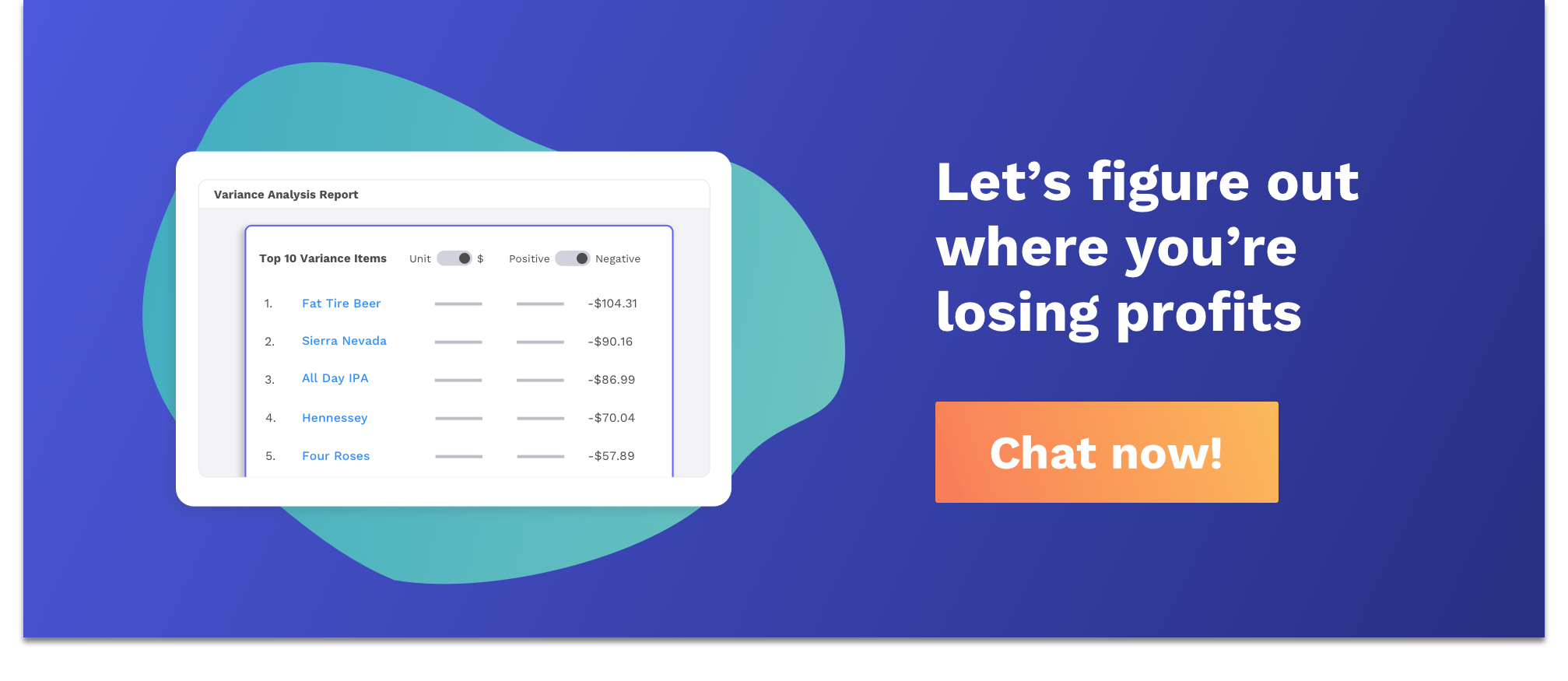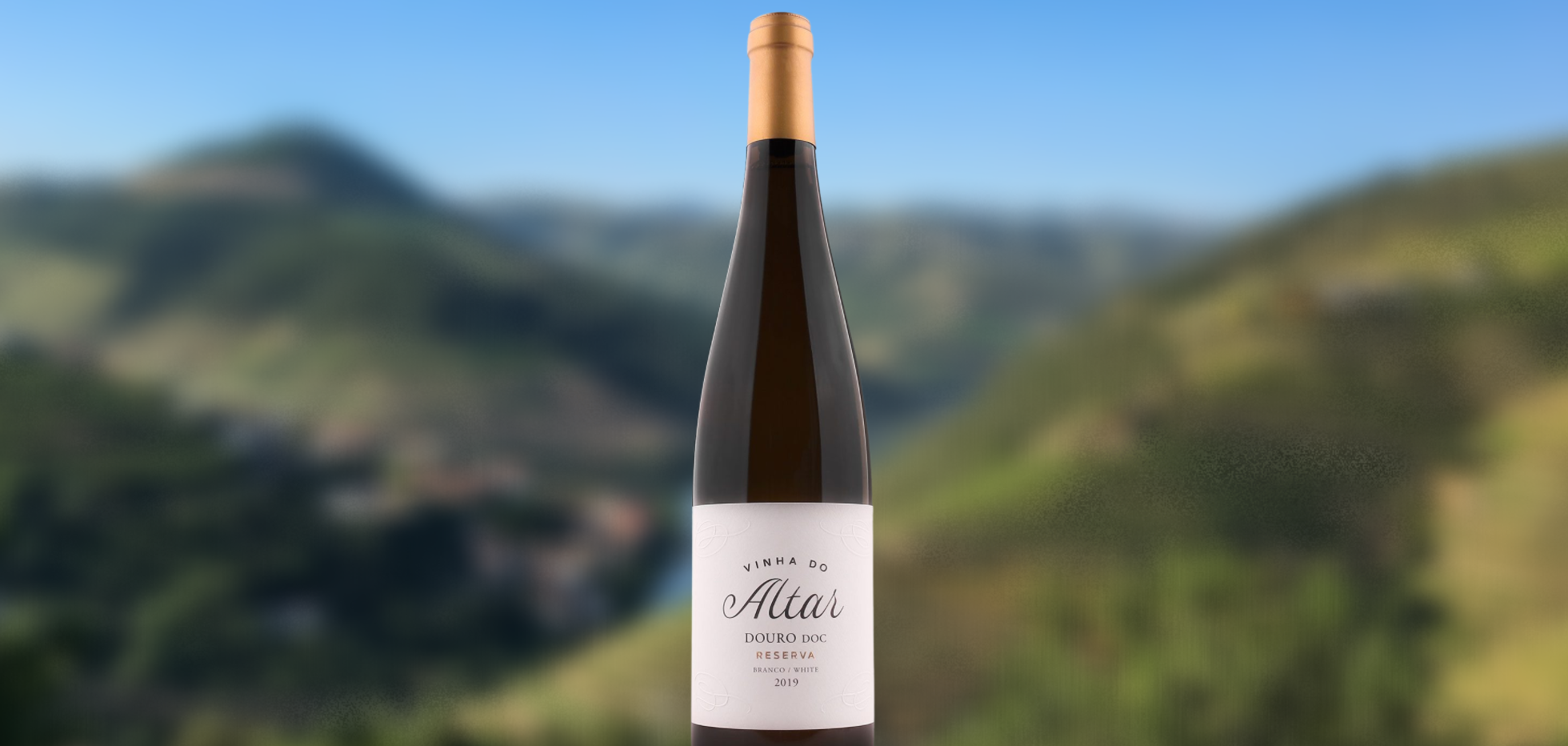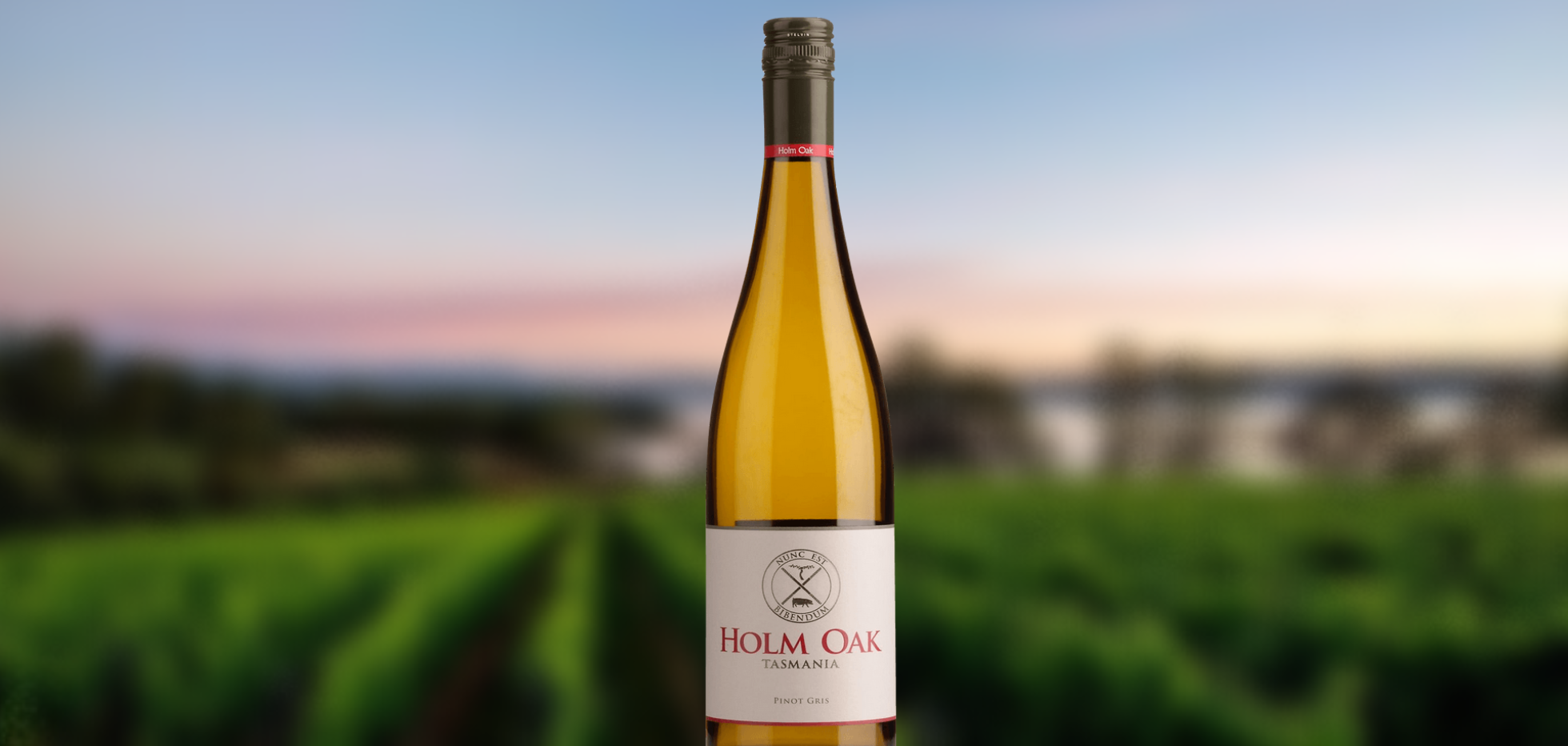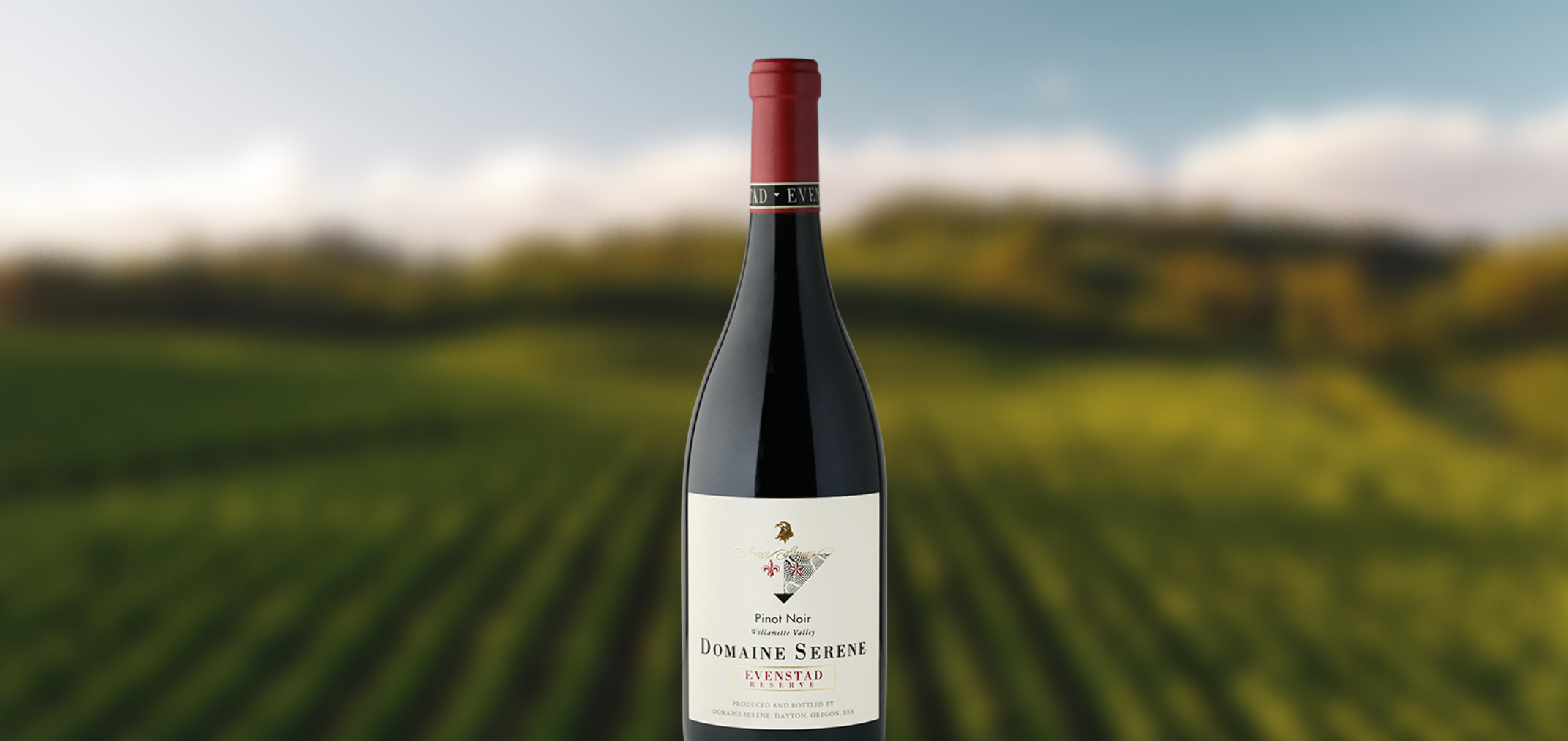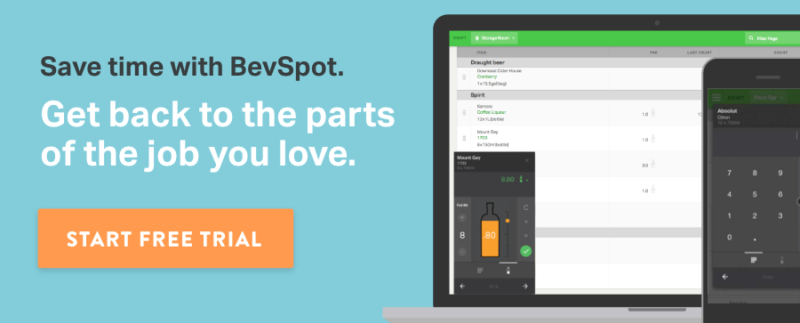Mastering Recipe Costing: Best Practices and Tools for Success
Best Practices and Tools for Success in Recipe Costing
Recipe costing is a crucial aspect of running a successful restaurant. By accurately calculating the cost of each menu item, restaurant owners and managers can make informed decisions, optimize pricing strategies, and ensure profitability. In this blog post, we will delve into the best practices and tools for mastering recipe costing in the culinary world.
Standardize Recipes:
Start by standardizing your recipes to ensure consistency and accurate costing. Clearly define the ingredients, quantities, measurements, and preparation methods for each menu item. This standardization lays the foundation for effective recipe costing and allows for easy adjustments and scaling. Check out one of our blog recipes and see if it’s a good fit for your business.
Assign Ingredient Costs:
Assign costs to each ingredient used in a recipe. Keep an updated database of ingredient prices, taking into account factors such as seasonality and supplier variations. Consider direct costs, such as the purchase price, as well as indirect costs like shipping and storage expenses. Regularly review and update ingredient costs to maintain accuracy. Check out BevSpots Recipe Cost Calculator.
Include Recipe Yield:
Take into account the yield or portion size when costing a recipe. Calculate the quantity of the final product that each recipe generates. This information is crucial for accurately determining ingredient costs per serving and enables better cost control and portion management.
Factor in Waste and Loss:
Account for waste and loss when calculating recipe costs. Some ingredients may have trimmings, peels, or other portions that are not used in the final dish. Estimate and include these factors in your calculations to ensure more accurate costing and avoid underestimating costs.
Consider Overhead Costs:
In addition to ingredient costs, consider overhead costs when costing recipes. Overhead costs include expenses such as labor, utilities, rent, and equipment depreciation. Allocate a portion of these costs to each recipe based on factors like preparation time and equipment usage.
Utilize Recipe Costing Tools:
Leverage technology and utilize recipe costing tools to streamline the process. Recipe costing software or spreadsheets can automate calculations, track ingredient costs, and provide comprehensive cost breakdowns. These tools save time, reduce errors, and provide valuable insights into the cost structure of your recipes.
Perform Regular Cost Analysis:
Conduct regular cost analysis to monitor recipe profitability and identify areas for improvement. Compare actual costs against projected costs to identify any discrepancies or cost overruns. This analysis helps you make informed decisions about pricing, ingredient sourcing, and menu optimization.
Update Prices Strategically:
Regularly review and adjust menu prices based on recipe costs, market trends, and customer preferences. Striking the right balance between profitability and competitive pricing is crucial. Consider the impact of price changes on customer demand and evaluate the potential effect on overall revenue.
Monitor Inventory and Suppliers:
Efficient inventory management and supplier relationships contribute to accurate recipe costing. Implement inventory control systems to track ingredient usage, minimize waste, and identify discrepancies. Establish relationships with reliable suppliers who offer competitive pricing and ensure consistent quality.
Train and Involve Staff:
Educate your staff about the importance of recipe costing and involve them in the process. Provide training on portion control, waste management, and cost-conscious practices. Encourage open communication and feedback from the kitchen team to identify cost-saving opportunities and improve overall efficiency.
Mastering recipe costing is essential for restaurant success. By following best practices such as standardizing recipes, assigning ingredient costs, factoring in waste and overhead expenses, utilizing technology tools, and conducting regular cost analysis, you can make informed decisions and optimize profitability. Effective recipe costing empowers you to price your menu items strategically, control costs, and achieve long-term financial stability in the competitive culinary industry.
Schedule 15mins to chat with a product specialist
Start a FREE Trial Today! BevSpot offers full product education and account setup for all customers! No card Information needed!
The Art of Hospitality: Creating Memorable Guest Experiences
The Art of Hospitality: Creating Memorable Guest Experiences
Hospitality is the heart and soul of the restaurant industry. Beyond serving delicious food, creating memorable guest experiences is essential for building customer loyalty and establishing a positive reputation. In this blog post, we will explore informative and factual insights into the art of hospitality and how it can elevate your restaurant’s success.
Warm and Welcoming Atmosphere:
The first impression is crucial in setting the stage for a memorable guest experience. Create a warm and welcoming atmosphere by paying attention to details such as lighting, decor, and music. Train your staff to greet guests with a genuine smile, offering a friendly and inviting ambiance that makes them feel valued and comfortable from the moment they step through the door.

Personalized Service:
Every guest is unique, and providing personalized service can make a lasting impact. Train your staff to actively listen to guests’ preferences, dietary restrictions, and special requests. Remembering regular guests’ names and their preferred dishes or drinks demonstrates attentiveness and creates a personalized experience that goes beyond mere transactions.
Anticipate and Exceed Expectations:
Hospitality is about anticipating guests’ needs and going the extra mile to exceed their expectations. Train your staff to proactively address potential issues, such as refilling water glasses or providing timely recommendations. Surprise guests with unexpected gestures like complimentary appetizers or personalized notes, leaving a positive and memorable impression.
Seamless and Efficient Service:
Efficiency is a key aspect of providing excellent hospitality. Streamline your restaurant’s operations to ensure smooth service flow, from taking orders to delivering food and settling bills. Invest in technology such as point-of-sale systems and order management platforms to minimize wait times and maximize staff productivity, allowing them to focus on delivering attentive and personalized service.
Exceptional Product Knowledge:
Well-informed staff who possess extensive knowledge about your menu, ingredients, and beverage offerings contribute to a memorable guest experience. Train your team to confidently answer questions and provide detailed descriptions of dishes, including potential allergens or dietary information. This empowers guests to make informed decisions and enhances their overall dining experience. Networking with others in the hospitality industry will help you stay up to date with trends to teach to your staff.
Handling Guest Feedback:
The way you handle guest feedback can significantly impact their experience. Encourage an open feedback culture and ensure that guest concerns or issues are addressed promptly and professionally. Use feedback as an opportunity to learn and improve, showcasing your commitment to guest satisfaction and creating a positive perception of your restaurant.
Building Genuine Connections:
Authenticity and building genuine connections with guests are vital elements of exceptional hospitality. Encourage your staff to engage in conversations, showing a genuine interest in guests’ experiences and stories. This personal touch helps establish emotional connections and fosters a sense of loyalty and belonging.
The art of hospitality is about creating memorable guest experiences that extend beyond serving food. By cultivating a warm and welcoming atmosphere, providing personalized service, anticipating and exceeding expectations, delivering seamless and efficient service, possessing exceptional product knowledge, handling guest feedback with care, and building genuine connections, you can elevate your restaurant’s success. These elements of hospitality contribute to guest satisfaction, loyalty, positive word-of-mouth, and ultimately, the long-term success of your establishment. Embrace the art of hospitality and create unforgettable guest experiences that will keep guests coming back for more.
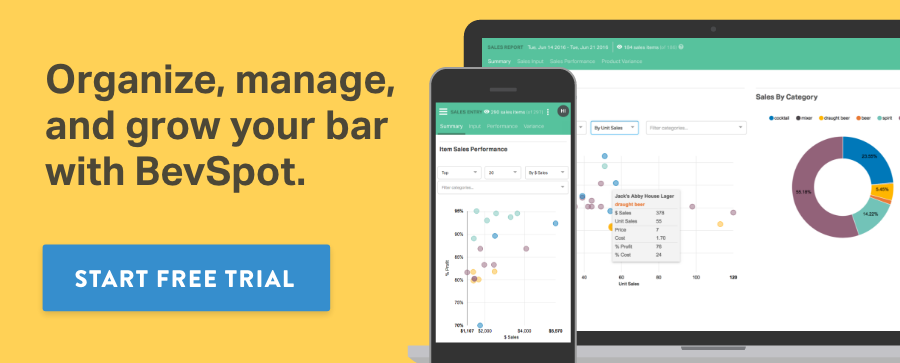
Schedule 15mins to chat with a product specialist
Start a FREE Trial Today! BevSpot offers full product education and account setup for all customers! No card Information needed!
Creating a Positive Work Culture: Strategies for Employee Satisfaction and Retention
Strategies for Employee Satisfaction and Retention
A positive work culture is essential for fostering employee satisfaction, engagement, and retention. When employees feel valued, supported, and motivated, they are more likely to contribute their best efforts and remain loyal to their organization. In this blog post, we will explore effective strategies for creating a positive work culture that promotes employee satisfaction and retention.
Encourage Open Communication:
Open and transparent communication is the foundation of a positive work culture. Establish channels that encourage employees to share their ideas, concerns, and feedback. Actively listen to their input, provide constructive feedback, and make them feel heard and valued. Regular team meetings, suggestion boxes, or anonymous feedback surveys can facilitate communication and create a supportive environment. Check out our resource about employee bar technology to help with open communication.
Foster a Collaborative Environment:
Promote collaboration and teamwork by encouraging cross-departmental interactions and shared goals. Create opportunities for employees to collaborate on projects, exchange knowledge, and learn from one another. Foster a sense of unity and cooperation that transcends individual roles and departments, strengthening the overall work culture and encouraging a supportive atmosphere.
Recognize and Reward Achievements:
Recognizing and rewarding employee achievements is crucial for boosting morale and creating a positive work culture. Acknowledge and celebrate individual and team accomplishments, whether through public recognition, incentives, or rewards. This recognition reinforces a sense of value, motivates employees, and fosters a culture of appreciation and encouragement. Being an effective manager is crucial in order to create overall success, check out our source on bar managing tips.
Support Work-Life Balance:
Promote a healthy work-life balance by offering flexible work arrangements, such as remote work options, flexible scheduling, or compressed workweeks. Encourage employees to prioritize self-care and personal commitments, as this leads to increased job satisfaction and reduced burnout. Supporting work-life balance demonstrates a genuine concern for employee well-being and contributes to a positive work culture.
Provide Growth and Development Opportunities:
Invest in employee growth and development by offering training programs, mentorship opportunities, and career advancement paths. Encourage employees to set professional goals and provide the necessary resources and support to help them achieve those goals. When employees see opportunities for growth within the organization, they are more likely to stay engaged and committed.
Lead by Example:
Leaders play a vital role in shaping the work culture. Lead by example, demonstrating integrity, empathy, and respect in your interactions with employees. Encourage a positive work environment by fostering a sense of trust, fairness, and open communication. When leaders embody the values and behaviors they expect from their team members, it sets the tone for a positive work culture.
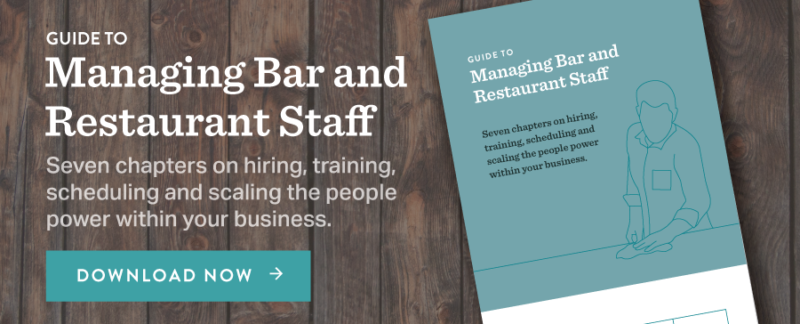
Foster Work-Life Integration:
Encourage work-life integration, which focuses on finding harmony between work and personal life instead of treating them as separate entities. Provide resources and support for employees to manage their personal responsibilities alongside work commitments. By promoting a holistic approach that acknowledges and supports employees’ personal lives, you foster a positive work culture that values the whole person.
Creating a positive work culture requires a deliberate and ongoing effort to prioritize employee satisfaction and retention. By fostering open communication, collaboration, recognition, work-life balance, growth opportunities, leading by example, and supporting work-life integration, organizations can cultivate a work environment where employees feel valued, motivated, and empowered. A positive work culture not only leads to higher employee satisfaction and retention but also enhances overall productivity and success.
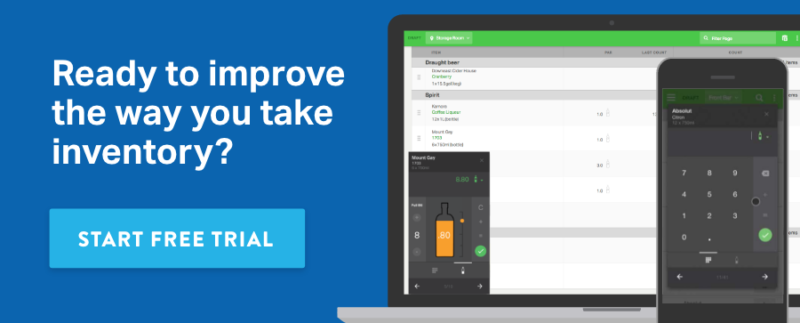
Schedule 15mins to chat with a product specialist
Start a FREE Trial Today! BevSpot offers full product education and account setup for all customers! No card Information needed!
The Importance of Accurate Inventory Valuation in Restaurant Accounting
The Importance of Accurate Inventory Valuation
Accurate inventory valuation is a critical component of restaurant accounting. It provides valuable insights into the financial health, profitability, and operational efficiency of a restaurant. In this blog post, we will explore the importance of accurate inventory valuation in restaurant accounting and the implications it has on decision-making and financial reporting.
Cost of Goods Sold (COGS) Calculation:
Accurate inventory valuation is essential for calculating the cost of goods sold (COGS) accurately. COGS represents the direct costs associated with producing the food and beverages sold in a restaurant. By properly valuing inventory, restaurants can determine the true cost of the ingredients and supplies used in their dishes, enabling them to calculate COGS accurately. This information is crucial for determining the gross profit margin, assessing profitability, and making informed pricing decisions.
Financial Reporting and Tax Compliance:
Accurate inventory valuation is necessary for preparing financial statements, including the balance sheet and income statement. The value of inventory impacts the balance sheet, affecting assets, liabilities, and owner’s equity. It also influences the calculation of net income on the income statement. Properly valuing inventory ensures the financial statements reflect the true value of assets and liabilities, providing stakeholders with reliable information for decision-making.
Moreover, accurate inventory valuation is essential for tax compliance. Tax authorities require businesses to report inventory accurately, as it affects taxable income and the calculation of taxes owed. Proper valuation methods and adherence to tax regulations are vital to avoid penalties or audits.
Operational Efficiency and Cost Control:
Accurate inventory valuation helps in assessing operational efficiency and implementing effective cost control measures. By tracking the value of inventory over time, restaurant owners can identify trends and patterns, such as excessive waste, spoilage, or theft. Timely identification of such issues allows for corrective action, reducing costs and improving profitability.
Accurate inventory valuation also enables restaurant owners to manage their supply chain effectively. It helps in determining optimal reorder points, avoiding overstocking or stockouts, and maintaining a healthy balance between inventory levels and customer demand. (Bevspot also knows a thing or two about controlling beverage costs, check out the linked article to find out more)
Decision-Making and Planning:
Accurate inventory valuation provides valuable data for decision-making and strategic planning. It helps in determining the profitability of menu items, assessing the viability of new dishes or promotions, and identifying the most cost-effective suppliers. Accurate inventory valuation also supports forecasting and budgeting activities, allowing restaurant owners to plan their operations, set sales targets, and manage cash flow effectively.
Accurate inventory valuation is crucial for effective restaurant accounting. It ensures accurate calculation of the cost of goods sold (COGS), facilitates financial reporting and tax compliance, and helps in assessing operational efficiency and cost control. Accurate inventory valuation provides valuable insights for decision-making, planning, and pricing strategies. By implementing robust inventory management systems, leveraging technology, and adhering to proper valuation methods, restaurant owners can maintain accurate inventory records and derive the maximum benefits from accurate inventory valuation in their financial management processes.
Schedule 15mins to chat with a product specialist
Start a FREE Trial Today! BevSpot offers full product education and account setup for all customers! No card Information needed!
The Keys to a Clean and High-Quality Scanning Process for Invoices
Unleashing the Magic of OCR for Invoice Processing

Optical Character Recognition (OCR) is reshaping invoice processing for the restaurant industry. It’s like a magical spell that automates data extraction, making your business operations smoother. But to experience the full power of this tech wizardry, we need to get our invoices ready for scanning in the best way possible. So, let’s dive right into why a spick-and-span scanning process is so essential for your invoices, and will lead to an efficient ordering and inventory process.
Dedicated Scanners and Mobile Apps are your friends
Most importantly, when you’re getting your invoices set for OCR, think about leaning on a dedicated scanner or a trusty mobile scanning app. These handy gadgets and apps are crafted to snap crisp, clear images, making it a breeze for the OCR software to read. With a dedicated scanner, you’re getting a top-notch resolution and cutting-edge image enhancement features for a world-class scan quality. But don’t underestimate mobile scanning apps; they’ve got the power of convenience and flexibility, letting you capture invoice images with just a click on your smartphone.
A couple recommendations from the Bevspot team:
- AI-powered scanning apps
Let There Be Light! (But Not Shadows or Reflections)
Lighting is a bit of a superstar when it comes to high-quality scans for OCR. Make sure your invoice is basking in the glow of a well-lit setting, without any pesky glare, shadows, or reflections playing spoilsport. The best approach is using natural light or a stable and evenly spread artificial light source. Just lay the invoice on a flat surface and tweak the lighting to shoo away any uninvited variations in brightness or contrast. Perfect lighting boosts the text’s legibility, letting the OCR software extract the needed info spot on.

Alignment is Key: Keep the Invoice Square in the Scanning Area
For a smooth OCR run, remember to align your invoice neatly within the scanning zone. Keep the edges of the invoice parallel to the scanning bed’s edges or follow the guidelines your mobile scanning app provides. This crucial step makes sure your whole invoice gets into the image without being cropped or distorted. The right alignment makes the OCR software’s job easier, leading to pinpoint text recognition and data extraction.
Quality Check and Redo Scans if Required
Finally, once you’ve got the scan, take a quick minute to eyeball the image quality before firing up the OCR. Keep an eye out for any blurriness, smears, or other gremlins that could throw off OCR’s accuracy. If you spot any, just retake the scan to get a clearer, sharper image. Trust us, it’s totally worth spending a few extra moments for a top-quality scan rather than risking wonky results in the OCR stage.
Getting your invoices primed for OCR starts with a clean-as-a-whistle, top-drawer scanning process. By buddying up with dedicated scanners or mobile scanning apps, mastering the right lighting, kicking out shadows or reflections, and getting the invoice alignment just right, you can boost OCR accuracy big time. A neat and sharp scan lets the OCR software read the text and extract the needed info like a pro. Embracing these best practices will help your business speed up invoice processing, save time, and cut down errors, ultimately pumping up your operational efficiency. How cool is that?
Here are some other tips for choosing the right technology to help run your business.
A Beginner’s Guide to Restaurant Food Costing
A Beginner’s Guide to Restaurant Food Costing
Anyone who’s responsible for managing a kitchen knows that one of the most critical aspects of running a successful restaurant is cost management. One area that requires close attention is food costing. With the right approach and tools, you can control your food costs, increasing your margins and profitability. In this post, we’ll give you an introduction into restaurant food costing, providing you with practical tips and tools to implement.
USE OUR FREE FOOD RECIPE COST CALCULATOR
Start with an Inventory
The first step in effective food costing is taking a regular inventory of your stock. Ideally, you should do this weekly or monthly, depending on the size of your restaurant. Tools like BevSpot make this process easier by centralizing and digitizing the process (no more spreadsheets!) and allowing multiple people to take inventory at the same time. Oh, and don’t forget to label all of your items!
Determine Your Menu Cost
To calculate your menu cost, you need to know the cost of each ingredient and how much of it you use to make each dish – down to the amount of salt and pepper, or even the garnish you use during the final plating! To do this, gather your recipes and break your menu items down into their constituent parts. Once you know every ingredient, its quantity, and its cost, you can determine the cost of production for each dish.
Assess Your Plate Cost and Profit Margin
Your plate cost equals the sum of the cost of the ingredients on the plate divided by the number of plates. Once you have your plate cost, you can determine your profit margin. Calculate your desired percentage profit margin and subtract it from your plate cost to find your menu price.
Need help costing out your menu? Our product specialists are here to help.
Control Your Food Waste
Waste can be a significant contributor to your food costs. Track your wastage and look for ways to reduce it by managing portion sizes, minimizing overstocking, and using yield optimization techniques. A critical factor in reducing waste is ensuring that your kitchen staff is well trained, the equipment is functioning correctly, and the food is stored appropriately.
Use Technology and Analyze Customer Data
Several tools and platforms can improve your restaurant’s food costing. For instance, many restaurant management systems like BevSpot offer inventory and food costing functionality. You can also use integrations with POS systems like Toast and Square to run customer data analysis to track menu item popularity, assess profitable trends, and identify food cost problems.
Keeping it Simple
Restaurant food costing doesn’t have to be complicated. By regularly taking inventory, determining your menu cost and assessing your plate cost and profit margin, controlling food waste, and using technology, you can improve your restaurant’s cost management and increase profits. With these cost management techniques in mind, you’ll ensure you have a successful, profitable restaurant that continues to thrive in this competitive market.
Stay tuned for a more in-depth look at food recipe costing!
Bar Inventory 101: How to Keep Track of Your Stock
If you run a bar, you know inventory is the backbone of your business. It’s what keeps you serving or what stops a sale if you don’t have enough of an ingredient on hand. While running out of stock can sometimes be a sign of good business, continuously over or under ordering can create big problems for bars and increase costs and customer dissatisfaction.
The hospitality business can be a challenge, and highly competitive, which means bar owners need to always be on top of costs and stock. This is where inventory management comes in. Proper inventory management can mean the difference between long-term success and profit or big time losses. It’s time to take control of your inventory with everyday essentials that will keep you stocked and serving.
Why is inventory management important?
Inventory management is an essential component of any food and beverage establishment. For bars, this means keeping track of both food (if offered), and liquor. With inventory management, bar owners and managers can have a better understanding of how much inventory they need to order, how much they have on hand and left over and how much is wasted or spoiled. The more actionable data you have, the better your purchasing decisions will be.
Keeping track of your inventory
Inventory tracking isn’t just a one-time thing, it’s a continuous part of restaurant management. How often you keep track can have a big impact on everything from customer satisfaction to sales.
Inventory management basics
From how much inventory you’ve used in a certain time period to how much each individual drink ingredient costs, there are several important formulas and concepts to keep in mind when starting your bar’s inventory management.
- Variance
- Usage
- Sitting inventory
- Pour cost
- Par level
- Safety stock
Variance
Variance, also known as shrinkage, is the difference between your product’s cost and the usage (more on that later). Some variance is common in every establishment. However, if the number is too high you’ll need to take a closer look at your operations to understand where your products are going missing.
The formula to calculate Variance is:
Variance = Cost of Goods Sold – Inventory Usage
Usage
Usage refers to the amount of inventory that’s been used up during a specific timeframe. This formula gives you a good idea of how much product you’re going through during a set period of time, allowing you to better understand which products you need to make sure you restock.
The calculation is as follows:
Usage = Starting inventory + Inventory added – Ending inventory
Sitting inventory
This refers to the amount of inventory you’re carrying at any given time. This can be tracked by product amount or dollar value. When counting your sitting inventory, choose one unit of measurement at a time and use that continuously.
Pour cost
Pour cost takes a close look at the cost of each ingredient in a specific drink, and the price of the drink. By looking at the cost of each ingredient, compared to the overall price of the drink, you’ll have a good idea of how profitable your drinks are. Doing an analysis of your pour cost with all your menu items will give you a clear idea of which drinks to keep and which to remove from your menu.
The formula to calculate pour cost is as follows:
Pour cost = Usage / Total Sales
Par level
Par level is the amount of inventory you need to have to meet your usual demand. How you calculate this will depend on the amount of deliveries you receive in a specific time period. While inventory levels should be based on your par level calculation, bars will likely have higher inventory levels during busy seasons or holidays. For example, a sports bar would likely stock above their par level during Superbowl weekend.
If you want to calculate it on a weekly basis, the calculation would be as follows:
Par level = (Weekly usage + Safety stock) / Number of deliveries in a week
Safety stock
Safety stock is the additional stock you keep on hand for emergencies or in case you have unexpected demand. While having a lot of inventory on hand for emergencies might seem like a good idea in theory, it could end up costing your bar a lot of money if it isn’t used. Generally speaking, safety stock should be around 20-30% of your weekly usage.
Automating your inventory tracking
Thankfully, inventory tracking doesn’t need to be a manual process anymore. By opting for an cloud-based point of sale system with inventory management tools, inventory can be automated and can provide you with actionable insights that help you make better purchasing decisions.
An automated inventory management system lets bars and pubs:
- Eliminate manual stock counting
- View existing inventory and inventory value
- See real-time deductions when drinks or other menu items are ordered
- View automatic replenishments when inventory is received
- Reduce waste and manage costs
- Calculate recipe costs and margins by tracking every ingredient
Opting for the right point of sale partner can mean the difference between a cumbersome, highly manual process and a simple, automated one. For example, Lightspeed’s integration with Bevspot lets bars track things like variance and product loss by item, as well as costs and pricing with user-friendly graphs.
Take control of your inventory with automated inventory management
Running a bar is a huge undertaking, but managing your inventory doesn’t have to be. The right tools that give you data you can act on and insights that help you handle costs will let you focus on what you do best and keep serving no matter what.
Schedule 15mins to chat with a product specialist
Start a FREE Trial Today! BevSpot offers full product education and account setup for all customers! No card Information needed!
Lightspeed?
Powering the businesses that are the backbone of the global economy, Lightspeed’s one-stop commerce platform helps merchants innovate to simplify, scale and provide exceptional customer experiences. Our cloud commerce solution transforms and unifies online and physical operations, multichannel sales, expansion to new locations, global payments, financial solutions and connection to supplier networks.
Cósmica Offers Tasty Alternatives to the Cinco de Mayo Classic
How this South End staple is gearing up for its fiesta – giving guests more than just your typical margaritas to tacobout.

Situated in the heart of the South End, often deemed as Boston’s best food neighborhood, and nestled in a Condé Nast Traveler’s 2019 #1 Hotel in Boston, The Revolution Hotel, Cósmica is just one of Wildlife Hospitality’s three iconic locations and its only Cal-Mex style restaurant.
That’s why there’s no surprise that Cósmica is planning a Cinco de Mayo celebration that will seemingly be out of this world. Apart from the piñata, they’ve also got a few cocktails to rival just your typical house margaritas – although they have plenty of those to go around too.
Here are some of their unique margarita-esque drinks that will be sure to shake things up this Thursday (pun intended):
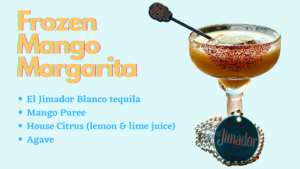
Frozen Mango Margarita:
“If you’re looking for a thirst-quencher as summer approaches, our Frozen Mango Margarita has got you covered! With bright notes from our Mango Puree and a creamy consistency that’s blended to perfection, the Frozen Mango Margarita will keep you cool in any weather!”
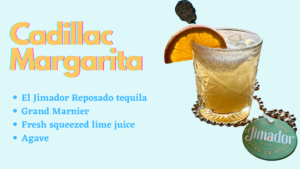
Cadillac Margarita
“In the mood for something refreshing and smooth? Look no further than our version of this luxurious classic! Made with Reposado tequila and Grand Marnier, this drink is sure to strike your fancy!”
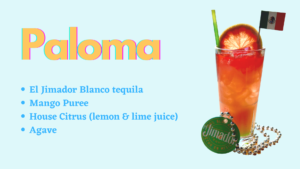
Paloma
“No party is complete without a Paloma! We keep it simple with El Jimador Blanco tequila that gets a tangy boost from a splash of grapefruit and lime juice. While we keep this classic close to its original recipe, it gets a tangy twist with a rim of our house-made Chili-Sour-Sugar!”
Next holiday, try putting a twist on a classic menu item – piñata optional but always encouraged.
BevSpot?
We’re a cloud-based food and beverage management software for inventory, ordering, invoicing and access to your establishment’s critical sales data. So you can grow your business faster—from anywhere. We’re here to help.
BevSpot’s Free Recipe Calculator
BevSpot’s Profitability Report
Wildlife Hospitality?
Wildlife Hospitality is a family of independent restaurants that seek to transcend traditional hospitality by offering multi-dimensional, immersive experiences, deeply rooted in and inspired by relevant history and culture. Every aspect of each concept is meticulously designed and extensively researched with a goal of transporting guests upon arrival. We are proud to serve hundreds of thousands of customers each year, navigating the delicate balance between consistency, quality and high volume.
Locations:
Build Your Restaurant Back Better and Embrace the “New Normal”
Build Your Restaurant Back Better and Embrace the “New Normal”
By Megan Prevost from MustHaveMenus
Since 2020, the restaurant industry has been on the rocks. With closures and strict policies, it’s been hard for restaurants to find success in the same ways they used to. After two years, the pandemic seems to be slowing down. Although there’s no way to be certain we’re out of the weeds, it’s a good idea to start looking forward. Unfortunately, things will never be the same as they were before the pandemic happened, so it’s time to address the “new normal” and think about how your restaurant can fit into people’s new and ever-changing lifestyles.
How Has the Pandemic Affected Restaurants?
The pandemic rocked the restaurant industry, causing massive shutdowns amidst the global lockdown. Some restaurants were able to open back up after the lockdown, but many decided to close their doors for good, unable to keep themselves afloat without their daily income. The restaurants that were able to reopen in the summer of 2021 did so with strict guidelines. Some chose to only offer takeout and some offered smaller menus and socially distanced seating plans.
Even after restaurants were opened again at full capacity, dining wasn’t the same. Because of the labor shortage, staffing was increasingly more difficult, making it hard to provide quality service. On top of that, guests and employees were still required to follow specific guidelines, like complying with temperature checks or following mask and vaccine mandates.
It’s unlikely that dining will return to normal any time soon, so it’s time to start looking forward to a better, more satisfying dining experience across the board. How can we embrace these protocols while still moving forward?
What Will the “New Normal” Look Like?
As of right now, the “new normal” consists of skeptic diners, protocols for employees, labor shortages, and more. There are plenty of people returning to restaurants, but some still have some (justified) anxiety about the entire experience. Most restaurants still have COVID-19 protocol signs placed around and hand sanitizer docked wherever necessary. These things make people feel safe and secure in the dining experience, and they likely won’t be going anywhere anytime soon.
Contactless experiences, like QR codes, likely won’t be going anywhere in the near future either. Guests enjoy being able to access restaurant menus without having to touch a menu that may or may not be wiped down between guests. However, at this time, it’s important to have both options available to satisfy all types of customers, including those that are sick of seeing QR codes everywhere.
It’s safe to say that we can continue to invest in the idea of automation and the contactless experience alongside alternative options. People enjoy being able to choose whether or not they have to interact with people, and with the ongoing labor shortage, it helps to offer these self-service options.
5 Tips for Embracing the “New Normal”
Now that we’ve discussed what the “new normal” might look like, it’s time to think about how your restaurant can embrace these changes and build back better. Whether you closed during the pandemic and are beginning to open up again or you’re just looking to invest more in your business, here are a few tips you should keep in mind.
1. Invest in Your Staff
Without a happy, well-trained staff, your restaurant can quickly fall apart. Stressed, burnt-out employees just don’t provide the same high-quality customer service that happy employees do. But how do you ensure that your employees stay happy and upbeat during such a downer of a time period?
First things first, try and make their “not-so-fun” jobs as easy as possible. BOH tasks like taking inventory and placing orders are imperative for your restaurant, however, they often get put on the back burner when you’re short staffed. Even more so if you don’t have the proper inventory and ordering systems in place to make the things on their to-do list as efficient and painless as possible.
Also to be considered is increasing your employees’ wages whenever possible. Raises offer a great incentive for employees and will help to decrease a high turnover rate, meaning you’ll spend less time training overall.
You can also offer benefits to your employees, such as health insurance, PTO, paid holidays, and more. Adding these extra benefits will help make your restaurant an appealing place to work and in turn, keep your employees happy.
2. Simplify Your Menu
We’re leaving complexities in 2019, because we just don’t have the time for a Cheesecake Factory length menu these days. Not only do customers suffer from choice paralysis with these long, laundry list menus, but they put more stress on the cooking and serving staff. Cooks have to prepare more foods and servers have to spend more time memorizing and learning about the different options. By offering a simplified menu, you can solve both of these problems.
Not only that, but simplified menus often reflect a more upscale, curated experience. With a simplified menu, you can also invest more into a few select dishes, ensuring that they’re absolutely delicious. With a large menu, it might be easier for a few not-so-tasty things to slip through the cracks.
Not sure which dishes to keep and which ones to toss off the menu? You may need to do a pulse check on each of their profitability. Those with a high profitability and a high popularity are the ones to prioritize whereas those with a low profitability and low popularity are the ones to think about removing.

What about the ones that are popular but possess a low profitability? You may need to “PIP” those menu items.
PIP:
- Price – Increasing the price on your menu item is a great way to easily increase its profitability.
- Ingredient – Swapping out one ingredient for a less expensive substitute is a less obvious way to make a dish more profitable.
- Portion – Lessening the portion of a dish is a great way to increase a menu item’s profitability if you know increasing the price or substituting an ingredient won’t work.
3. Streamline the Dining Experience
We should prepare to open customers back into our restaurants with open arms. While many customers have already begun to return, we need to ensure that we’re ready to make even the most hesitant of customers feel at home. By providing excellent customer service and delicious food, they’ll be reminded of why the dining experience is so special and different from other things we experience in life.
We’re not saying you should revert to the “classic” dining experience and remove all QR codes and contactless options, but put more emphasis on ensuring that your guests have a great time during their visits. Encourage servers to make personalized recommendations, and have your management staff check on tables to see how they’re enjoying their visits.
4. Offer Options for Hesitant Customers
Unfortunately, while many diners will return to your restaurant, there are many that will still choose to stay at home. And that’s okay! To ensure that you’re not keeping these customers out of the loop, make sure you continue to offer services that they enjoy, like high quality take out and curbside pick up.
If you’re able to sell alcohol in your state, keep doing it! People who enjoy eating from home love these options, and you shouldn’t take them away just because on-site dining is picking up.
5. Remember that Nothing is Set in Stone
The world is ever-changing, and it’s hard to predict exactly what might happen in 2022 and beyond. While you can work on embracing the “new normal” that we’re experiencing right this second, it’s important to remember that things could change at the drop of a hat anytime in the next few years.
Maybe we’ll switch completely to robot dining or maybe QR codes will disappear forever. There’s no way to know for certain, so keep an open mind and adapt to the changes as they come up.
Embrace the “New Normal” and Build Your Restaurant Back Better than Ever this Year
If you’ve been concerned about your restaurant’s business, now’s your time to shine! Use the tips listed above to build your restaurant back better and embrace the ever-changing world we live in today. Guests are returning to restaurants and it’s time to wow them with what you have to offer.
MustHaveMenus?
Restaurant menu design, printing, and online marketing all in one place. Helping you focus on what matters most to drive success.
BevSpot?
We’re a cloud-based food and beverage management software for inventory, ordering, invoicing and access to your establishment’s critical sales data. So you can grow your business faster—from anywhere. We’re here to help.
5 Women Operated Wineries and Wines to Pique Your Palate
There are countless talented women leaders within the wine industry
To celebrate women’s history month, I’d like to focus on a few that have shaped my palate over the past decade. In my time in the hospitality industry in stints as a restaurant manager, bar manager and beverage director, the following list has left a lasting impression on me of incredible wines at a wide range of price points. Whether stocking your own personal wine rack or searching for new wine features on a menu, these additions speak for themselves while also celebrating talented women leaders in winemaking.
No affiliate links, no paid promotion, just the genuine appreciation of wine and the talent behind it.
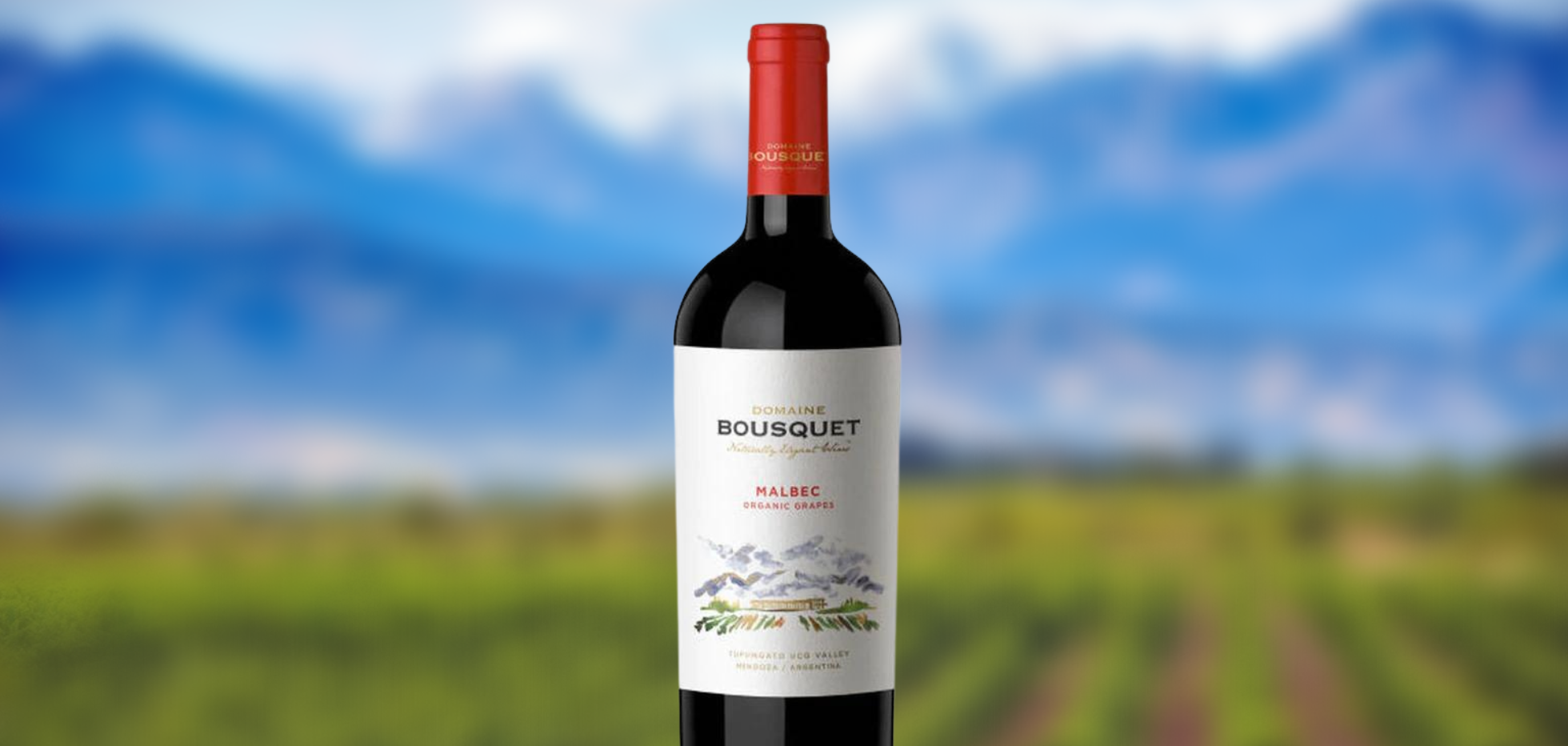
Domaine Bousquet
- Anne Bousquet, CEO, Co-founder
- Malbec, Mendoza, Argentina – $
Mendoza, Argentina has been a recent target for a new wave of European immigrants, bringing with them their knowledge in winemaking. Anne Bousquet, CEO and co-founder of Domaine Bousquet, is no exception, bringing her family’s experience from southern France to the region. Their Malbec is a wonderful and affordable example of the marriage between old-world and new-world winemaking; unoaked to showcase fruit-forwardness, medium acidity, and elegant tannins. Decanting or using an aerator will dramatically enhance these notes.
Wine & Soul
- Sandra Tavares, Co-Owner and Founder, Winemaker
- Vinha do Altar Reserva, Douro, Portugal – $
Sandra Tavares brings a well educated approach to winemaking having earned a master’s in enology in Italy, and bringing that knowledge back to the rich history of winemaking in Portugal. She has expressed a preference to creating white wines, since terroir is better expressed than with reds. Portugal can often be overlooked in the North American markets, but it’s having Atlantic and Mediterranean climates leads to unique palettes that are not easy to replicate in other appellations. In an area famous for Port wines, Vinha do Altar Reserva brings a crisp green apple, lemon and mineral palate that lends itself well to Portuguese cuisine staples of fish, shellfish and cured meats.
Imagery Estate Winery
- Jamie Benziger, Winemaker
- Sangiovese, Pine Mountain/Cloverdale Peak, California, USA – $$$
Jamie Benziger grew up in the wine industry and as a second generation winemaker, took any opportunity she could to further her knowledge in winemaking. Since taking over Imagery Estate Winery in 2017, she’s continued her family tradition of bringing traditional varietals with a twist. Imagery’s Sangiovese is a California wine-country example of an Italian varietal that features wonderful notes of cherry, mulberry and tobacco-ey oak. This Sangiovese manages to bring moderate body to a grape that lends itself to lighter, high acidity wines. If the name Benziger is familiar, be sure to check out sister winery Benziger Family Winery headed by director of winemaker Lisa Amaroli.
Holm Oak Vineyards
- Rebecca Duffy, Winemaker
- Pinot Gris, Tamar Valley, Tasmania, Australia – $$
Rebecca is a first generation winemaker, expanding upon her family’s history of Australian sheep and cattle farming to the Australian wine boom. The Tamar Valley of Tasmania has a similar in terroir to northeast France, specifically Champagne, and lends well to similar grape varieties. As a result, Tasmania produces some exquisite bubbly, silky pinot noirs, and identifiable whites. The mineral-driven and dry, yet moderately soft palate of this Pinot Gris is strongly reminiscent of coastal Spanish Albariño.
Domaine Serene
- Grace Evenstad, Founder
- Evenstad Reserve Pinot Noir, Willamette Valley, Oregon, USA – $$$$
As the most expensive bottle on this short list, Domaine Serene’s Evenstad Reserve Pinot Noir is a formidable example of the unmistakable quality of Pinot Noir produced in Oregon’s Willamette Valley. At the helm of this winery founded in 1989 is Grace Evenstad and husband Ken. Considered to be pioneers of Oregon’s luxury wine industry, Domaine Serene has received numerous accolades and recognition as an outstanding Pinot Noir. While it is common for old-world wineries to expand to new-world territories, Domaine Serene has taken the opposite approach and recently expanded their operations to Burgundy, France.
BevSpot?
We’re a cloud-based food and beverage management software for inventory, ordering, invoicing and access to your establishment’s critical sales data. So you can grow your business faster—from anywhere. We’re here to help.
Announcing a new partnership with Clubspeed!
BevSpot & Clubspeed Partner to Provide Best-In-Class Food & Beverage Management Solutions to Family Entertainment Centers Globally
To learn more about the benefits of using Clubspeed and BevSpot together speak with our team today!
February 17th, 2022 — BevSpot, one of the leading technology companies in the global food and beverage industry, and Clubspeed, the world’s leading venue management software for Family Entertainment Centers, announced a new partnership. The partnership provides a suite of BevSpot’s operational tools including mobile inventory, automated ordering, recipe costing and profitability tracking at a reduced rate for Clubspeed customers, providing them end-to-end visibility into their businesses’ performance and enabling them to take advantage of key opportunities to drive more revenue and increase profits within their F&B operations.
As more and more operators look to cloud-based solutions to save time and money, the enhanced feature set will help Clubspeed customers save time and increase profits. Seamlessly tracking real-time costs via BevSpot inventory, ordering & invoicing features, and combining it with sales data from Clubspeed’s POS product makes it easy for operators to identify top- and bottom-performing menu items and adjust costs to increase profits instantly. In addition, real-time profitability reports provide operators with the confidence to understand where their profits, not just their sales, are at any given time.
“We are beyond excited to see the integration between Clubspeed and BevSpot to simplify our food and beverage management program. BevSpot’s inventory management software partnered with Clubspeed’s live data will generate easy reporting tools to help us grow revenue and more easily manage our food and beverage program,” said Aaron Hirsch, Director of Operations at Full Throttle Adrenaline Park.
“We are thrilled to partner with Clubspeed to expand the functionality of their industry-leading offering for Family Entertainment Centers at a time when more people are looking to spend more time together sharing fun and safe experiences. Every operator deserves to have best-in-class F&B management software to ensure they are creating great guest experiences and contributing to their bottom line, and this partnership will allow us to provide those benefits to more operators globally,” said Rory Crawford, BevSpot’s Co-Founder & CEO.
“We are excited to partner with a leading cloud-based software solution for the Food & Beverage industry as so many of our customers are seeing this as a major area of growth and investment. I’ve known Rory and BevSpot since inception and I’ve been very impressed by their product offering and I know this partnership will deliver significant value and operational efficiency to current Clubspeed customers, and future Clubspeed customers,” said Alok Pandey, Clubspeed’s CEO.
About BevSpot
BevSpot builds easy-to-use online technology solutions for the global food and beverage industry. Through BevSpot’s food and beverage management software, customers can take control of their entire operation—from full-service restaurants to a grab-and-go smoothie and ice cream shops and even retail corner stores—on any device, all saved to the cloud. Today, BevSpot has empowered tens of thousands of users worldwide to make data-driven decisions and grow their business.
About Clubspeed
Clubspeed has the world’s leading cloud-based software for activity centers, revolutionizing the way venue owners and managers run their businesses every day. Serving karting facilities, trampoline parks, and multi-activity family entertainment centers, its features include kart timing, trampoline gamification, point-of-sale, marketing automation, and more. For more information, visit Clubspeed’s website at www.clubspeed.com.
To learn more:
Visit www.bevspot.com or if you’re a Clubspeed customer, talk to the Bevspot team to get your free account and start onboarding and training today — bevspot.com/integration/clubspeed.
Schedule 15mins to chat with a product specialist
Start a FREE Trial Today! BevSpot offers full product education and account setup for all customers! No card Information needed!
Top Spirits of Our 2021 World Series Champs
Congrats on the World Series win, Atlanta!
BevSpot thought this World Series win would be a great opportunity to take a deep dive into the Brave’s hometown’s liquor ordering habits. What spirits do restaurant-goers in the Big Peach love, and which brands are favored?
The Data
To start off, let’s touch base on the data used in this deep dive. We’ll explore data from all Atlanta-based BevSpot accounts, over the period beginning opening day, April 1st, until your World Series Win. Including any liquor and spirits, Atlanta’s ordering composition breaks down as follow:
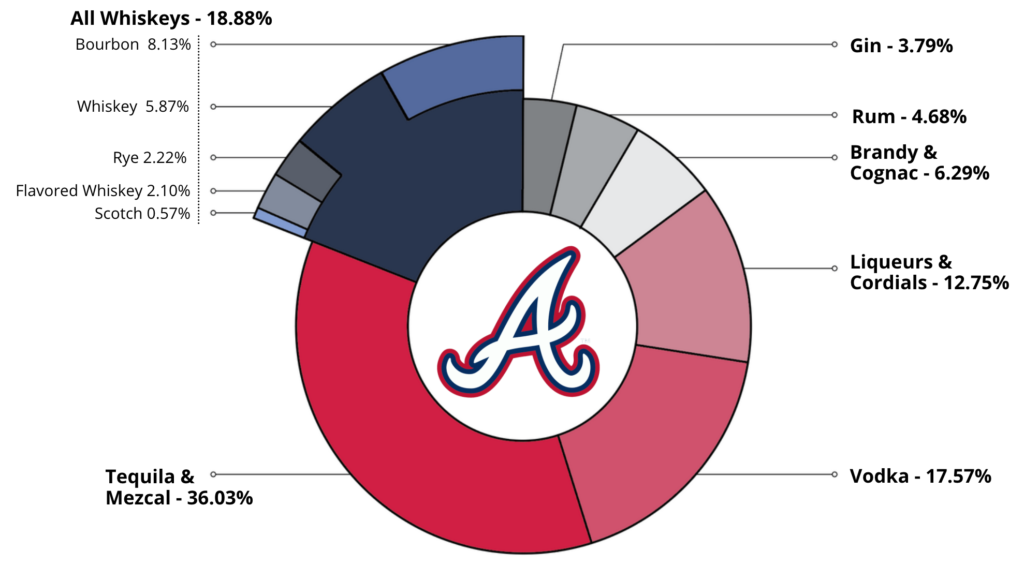
Atlanta Insights
Most surprisingly about Atlanta is a seemingly unquenchable thirst for tequila, and a big shout-out to a certain Atlanta taco group for pushing impressive amounts of it. As well as copious volume, there were nearly 200 different varieties ordered across all accounts. Aside from well tequila, Casamigos Blanco and Patron Silver make up the second and third most ordered liquor in the Atlanta area (respectively), with Don Julio Silver at fifth most popular by volume. Clearly, Atlanta’s got good tastes in tequila with all of those being higher-end brands.
Vodka is well represented in Atlanta, no surprise there, with Tito’s representing over a third of the vodka by volume ordered for BevSpot accounts in Hotlanta. Interestingly, vodka is the overall most popular ordered liquor in Georgia, narrowly ahead of tequila and whiskey by volume. We also see an above-average amount of brandy and cognac ordered in Atlanta. It’s almost three times as much as World Series second-place winner Houston, carried by Atlanta’s love for Hennessy cognac products. Hennessy VS is in fact the sixth most ordered liquor by volume for the city.
Being a part of Southern Appalachia, we figured it’d be good to go into more detail on Atlanta’s whiskey culture. Despite Irish whiskeys being popular across the U.S. (Jameson was the fourth most popular liquor by volume for Atlanta), a thirst for small-batch bourbons like those made by ASW Distillery and Savannah Bourbon helped bourbon dominate the top whiskey subcategory.
Atlanta’s Top 6 Spirits
Finally, what brands are popular? Just as the Astros only made it to game six against the Brave’s, we’ll list Atlanta’s top six brands.
- Tito’s Vodka
- Casamigos Blanco Tequila
- Patron Silver Tequila
- Jameson Irish Whiskey
- Don Julio Blanco Tequila
- Hennessy VS Cognac
Got any insights you’re curious about or want to harness your own data to help your restaurant run better? Check-in with one of BevSpot’s representatives to talk about data-driven features like variance reports, expected inventory, or profitability reports down to the minute.
Schedule 15mins to chat with a product specialist
Start a FREE Trial Today! BevSpot offers full product education and account setup for all customers! No card Information needed!
You Really Should Know How to Change a Keg
Can you change a keg?
Changing a keg is something every manager, or better yet, every employee should know in order to be a team player. It’s a right of passage. There’s actually a lot of draught maintenance you can handle for your bar to ensure your bar is running smoothly, without the downtime of waiting for a draught system professional. We’ll take a look at some fundamental draught maintenance skills like changing a keg, as well as the changing couplers, faucets, and gas tanks.
BevSpot strongly recommends you hire a professional to regularly maintain your draught system. This ensures that your beer tastes its best, and it can help minimize bar inventory loss from waste. They can also help with some of the maintenance addressed in the blog post (no, they won’t change a keg for you).
Start Your Free Trial With Bevspot Today!
How to Change a Keg
Let’s start with the one that is a rite of passage for new bartenders and managers: change a keg. You’ll know you’ve done it right if you’re not covered in beer once you’ve finished. To begin, there are several types of couplers (the part that connects the draught line to the keg), but most of them connect and disconnect similarly. They tend to look like this:
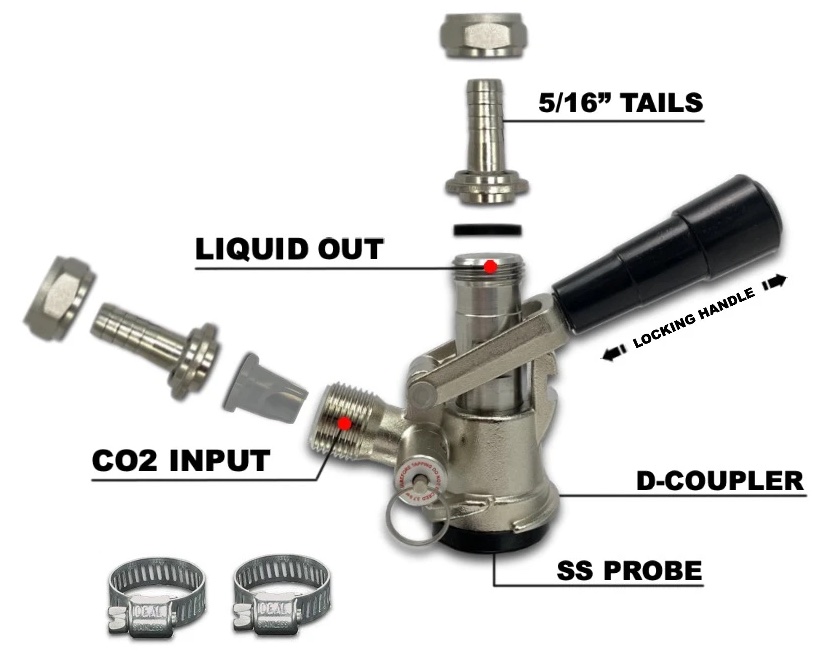 Type D Coupler (American Sankey)
Type D Coupler (American Sankey)
Most systems work the following way: CO2 or Nitrogen goes in the side tube and leaves the keg via the top tube.
To disconnect a keg:
- Grab the plastic locking handle and pull it out until to unlock it.
- With it out, you can safely lift the handle all the way up.
- You can now twist the coupler counterclockwise to release the keg. If you didn’t pull the handle all the way up in the previous step, you will be sprayed with beer.
If this requires a lot of force, consider cleaning your coupler.
To connect a keg, you’ll reverse the process.
- Fit the coupler into the top of the keg. Doesn’t fit? We’ll address that further on.
- Holding the handle and not the lines, twist the coupler clockwise until it is firmly locked in place.
- Firmly press down on the handle. It should lock into place.
After changing, you’ll need to drain the lines a little bit to get out any old beer. It may be a pint or two depending on the length of your draught lines. This is an example of variance that you should expect in your beverage program. In some instances, you may need to change a coupler for your keg to work with your draught system or for cleaning.
Replacing a Coupler
Thanks for the info BevSpot, but my coupler doesn’t fit the new keg. The good news is that those can be changed. Most kegs from widely distributed U.S. breweries use a Type D coupler, also known as an American Sankey. Bars with European beers on draught are likely to need other couplers. If you’re unfamiliar with a keg you’re looking to order, check with your beer distributor representative to make sure you have the correct coupler available to tap it.
To replace a coupler:
- Turn off the gas to your keg from the regulator. Larger systems may have individual regulars for each tap output. You’ll also need to detach the coupler from your keg.
- Generally, there are constant tension clamps ensuring a tight seal. They’re little rings with a bolt that adjusts how tight they are. If you have them, loosen them.
- Did you turn off the gas?
- Loosen the hex nuts that connect the gas and beer lines. The coupler will now be disconnected. Be prepared for any beer in the line to drain out.
- Connect the new coupler by reversing the process; connect the hoses and tighten the nuts, then tighten the tension clamps to ensure a snug fit.
- Don’t forget to turn the gas back on when you’re done. You can safely tap the keg.
Changing a Faucet
If you’re adding a Nitrogen stout to your draught line-up replacing a CO2 IPA, you’ll need to know how to swap out faucets. To do so, you need a beer faucet wrench. Some wrenches come with a faucet tool on one end and a hex wrench for couplers on the other.
 Faucet Wrench
Faucet Wrench
To change a faucet:
- Turn off the gas to that line from the regulator.
- At the base of the faucet, you’ll find a ring with a few small holes in it (this is called a shank collar). Approaching from the right side, put the tip on the wrench into one of the holes.
- Rotate clockwise to loosen the collar. Note that the collars operate backward from typical nuts; righty loosey lefty tighty in this case.
- Support the faucet with one hand and continue to loosen the collar manually.
- With the old faucet removed, we can follow a similar process to get the new one in place.
- After manually tightening the collar to the new faucet and ensuring the system is aligned vertically, you can tighten the collar with the wrench counterclockwise to ensure there are no leaks.
- Don’t forget to turn the gas back on when you’re done.
CO2 and Nitrogen
Used for soda as well as kegs, these gasses are expensive, and a leak or empty syrup can really add up to a substantial loss of both gas and profits. Many gas companies charge a leasing fee for canisters, so letting empty canisters sit around will also end up being an unnecessary cost. If your draught lines are pouring weak or flat, chances are you need to change your gas. For this, you’ll need a hex wrench like the one pictured below. Typically, this is left attached to the regulator at the gas canister so it doesn’t get lost.
 Hex Wrench
Hex Wrench
To change a gas canister:
- Turn off the gas by turning the knob on top of the canister clockwise. Even if the gas may be out, turn it off.
- Fit the wrench over the nut that couples the regulator to the canister. Loosen the nut by turning counterclockwise. These wrenches are pretty thin and don’t always get a good grip on the nut, so this can be frustrating at first.
- With the old canister detached reverse the process the attach a new canister.
- Once the canister is attached and the nut is tight, you can turn the gas back on.
A quick note on pressure (PSI): For CO2 beers, you’ll want 10-12 PSI, while Nitrogen beers need 35-30. These can vary slightly depending on your system, and you may need to adjust to get your beer perfect.
Conclusion
Having the knowledge and tools to help your bar run smoothly is crucial in running a profitable business; set your team up for success. Our goal at BevSpot is to provide you with all the tools you need to simplify bar managing duties such as faster inventory, facilitate ordering, and manage profitability.
Schedule 15mins to chat with a product specialist
Start a FREE Trial Today! BevSpot offers full product education and account setup for all customers! No card Information needed!
BevSpot’s Most Ordered Oktoberfests of October
Oktober is winding down.
For beer lovers in the U.S., October is synonymous with Oktoberfest-style beers showing up on tap and in stores. While in Germany, it traditionally runs from mid-September to the first Sunday in October, that schedule has been adapted to run until German Unity Day on October 3rd.
In the US, Oktoberfest is an opportunity to celebrate German heritage, with many breweries holding or sponsoring celebrations throughout October.
We’ve done another data deep-dive using BevSpot ordering data to find what the most popular Oktoberfest brands are (by volume) among bars and restaurants on the BevSpot platform. Out of the 154 different brews ordered, we’ve compiled a list of October’s top Oktoberfests, measured in ounces ordered.
BevSpot’s Top 7 Oktoberfest of October
Not represented on our list are 147 amazing lagers which make up 26.32% of orders.
Now, on to BevSpot’s frontrunners. Oans, zwoa, g’suffa!
-
Jack’s Abby Copper Legend Octoberfest (Massachusetts, USA)
Coming in at 2.69% of order volume, Jack’s Abby is a craft brewery out of Framingham, MA that specializes in lagers. In a market dominated by German beer, we are proud to see a Massachusetts brewer on our list. Prost!
Check out Jack’s Abby Copper Legend Octoberfest on Beer Advocate
-
Paulaner Brewery Oktoberfest Wiesn (Germany)
Established by friars in1634, Paulaner Brewery’s festbier was introduced to Oktoberfests in the 1950s as a less sweet alternative to Märzen. At 2.98% of BevSpot volume, this beer has limited availability. Historically, it has only been available at Paulaner Oktoberfest tents but was made available for retail due to Oktoberfest COVID-19 cancelations.
Check out Paulaner Brewery Oktoberfest Wiesn on Beer Advocate
-
Hacker-Pschorr Oktoberfest Märzen (Germany)
Formed in 1972 from the merger of two early 15th and 16th-century breweries, this Märzen came in with 4.55% of volume.
Check out Hacker-Pschorr Oktoberfest Märzen on Beer Advocate
-
Paulaner Brewery Oktoberfest Märzen (Germany)
At 8.48% of order volume, Paulaner has another offering on our list. Boasting a recipe over 200 years old, this beer is available year-round in the U.S., unlike their Weisn.
Check out Paulaner Brewery Oktoberfest Märzen on Beer Advocate
-
Hofbräu Oktoberfestbier (Germany)
This brewery owned by the Bavarian state government is another old one, from the 16th century. It gained popularity in the U.S. after World War II, and with franchises across the U.S., their Märzen weighs in at 9.84% of BevSpot volume.
Check out Hofbräu Oktoberfestbier on Beer Advocate
-
Spaten Oktoberfest (Germany)
As part of the Interbrew group (a subsidiary of the massive Anheuser-Busch InBev company), it’s unsurprising that this Märzen claims 19.15% of BevSpot’s Oktoberfest order volume.
Seeing a pattern here? German beers have fairly substantial penetration into the U.S. market. There are only a few breweries that are granted permission to participate in official Oktoberfest celebrations, and we see most of them represented on this list.
Check out Spaten Oktoberfest on Beer Advocate
Alrighty. It’s finally time to reveal our highest Oktoberfest by volume.
-
Samuel Adams OctoberFest (Massachusetts, USA)
We’re not really surprised to see Sam Adams OctoberFest topping the list. Plus, we’re proud to see another Massachusetts company on the list with a whopping 25.98% of BevSpot order volume.9
Check out Samuel Adams OctoberFest on Beer Advocate
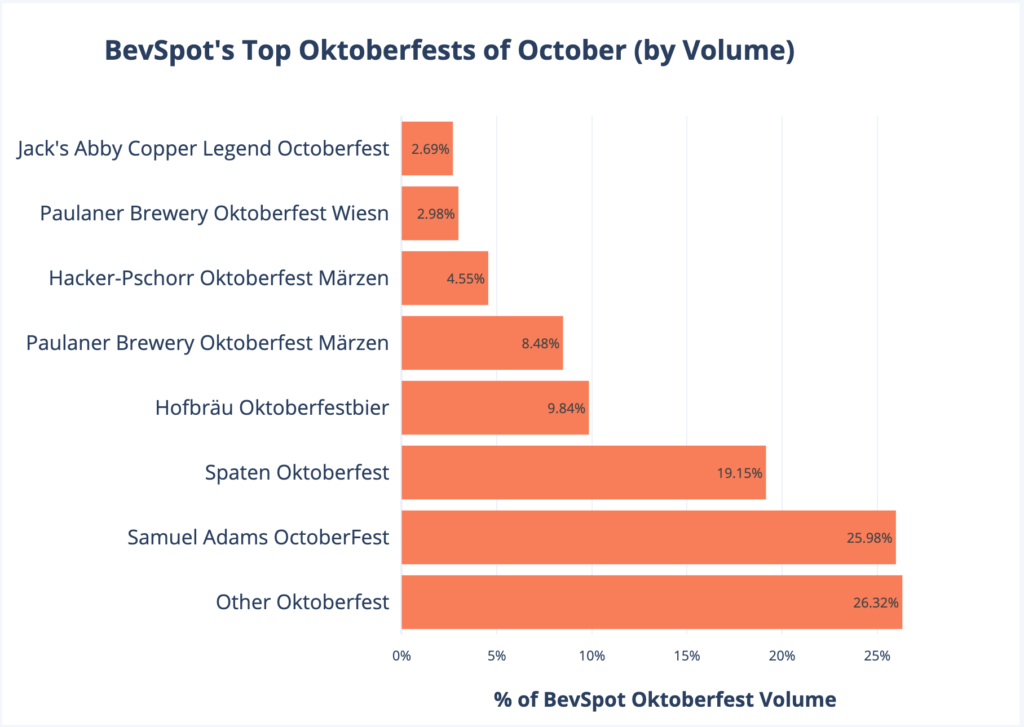
Leave a comment with your favorite Oktoberfest, or click below to learn more about BevSpot and how it can help your restaurant.
Variance, and How to Manage It
We talk a lot about beverage program metrics.
And, as a bar manager or beverage director, you probably know how to calculate them and what they mean. But understanding why these bar management metrics matter and the impact they can have on your profitability is just as important. Guess what…they’re all connected.
Let’s take a closer look at how pour costs and variance are related, how they affect profitability, and how to address discrepancies.
Why does pour cost matter?
Pour cost is a critical number for understanding the overall profitability of your bar and is measured by the cost of product usage divided by the sale amount. It is more a target that you establish when pricing out beverages, with the actual value being determined through your cost of goods sold. Designing menu items that fall within a favorable pour cost directly affects profitability.
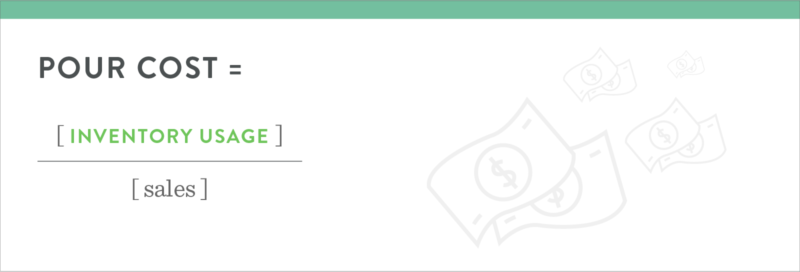
Profitability is influenced by three things: drink costs and drink pricing, as well as product loss. This product loss is referred to as variance, and this is where bar managers have incredible potential to impact a program’s bottom line. Variance is the difference between the amount of product sold during a given period of time and the amount of product used during that same period.
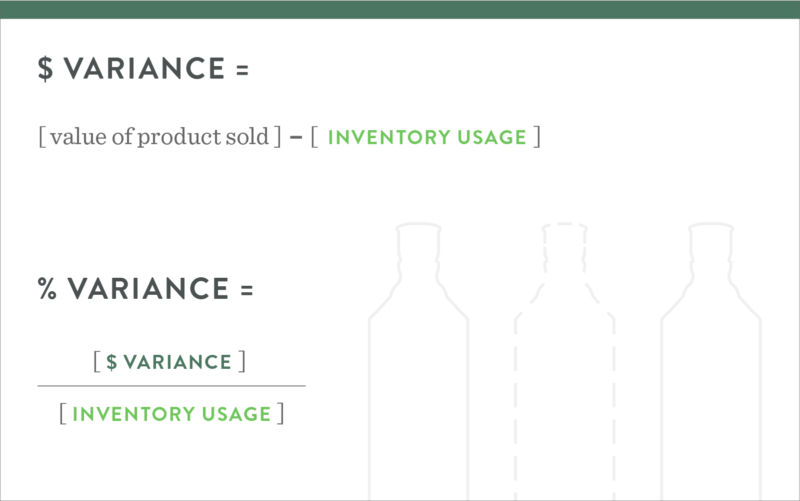
Within BevSpot, we offer a variance report that calculates this loss for you. Be sure to check out this video on variance to see how it could help your business meet tighter margins.

Why should you care about variance?
Variance is one of the biggest detractors from a beverage program’s profitability. It represents how much product you lost before you had a chance to sell it. Some minor variance is normal. For example, breakage is normal but isn’t always accounted for, free-pours aren’t generally perfectly accurate, and training new staff always increases variance. When that number begins to creep up, that is an indication there is an issue within your bar.
What can I do to manage variance?
If no steps are taken to reduce it, variance can drastically reduce your bar’s profits. Computing and interpreting your variance number is essential if you want to make strategic decisions and run a tight ship. This typically comes down to three main issues:
- Inaccurate inventory management
- Overpouring
- Theft
Great news, these are manageable. Do note that these are listed in a specific order. Never blame your team for an unexplained variance before you have taken time to determine if there may have been a mistake on your part first.
Inaccurate Inventory Management
If you’re the one who counts inventory for your program, it could be your fault. Particularly if you’re new to the position, there are many areas you could have miscounted. Save yourself the headache and take a moment to review our guide on taking liquor inventory right. Also, take time to make sure your invoices are properly processed and reflect what’s used in your bar.
Overpouring
Consistency is imperative in a bar; you want guests to enjoy the same incredible experience. Bartenders pouring different portioned drinks can lead to unhappy guests and high liquor cost variance. One managerial tool to remind your bartenders that consistency is essential is to administer a quick pour test at the start of each shift. Grab a graduated cylinder (just like it’s middle school science class) and have them aim for some common pour sizes with an old liquor bottle filled with water and a speed pour. This serves a few additional purposes:
- It makes your bartenders more aware of their pours.
- Identifies coaching and training opportunities.
- Establishes some healthy competition between bartenders.
Give them a few attempts, but don’t punish them for failing. This is an opportunity to show you’re serious about running a tight ship. With high-end spirits, consider a jigger.
Theft
While this is the last place you should consider for variance, it is common enough.
To be proactive and build accountability for what comes in and out of your storage areas:
- Take inventory regularly.
- Properly record your deliveries and compare them to your orders. With supply chain shortages, you may not receive what you order.
- Have your team document what they remove from your storage areas for each order period.
- At the end of that period, if there are discrepancies between pulls, par levels, and what is on hand, it may be time to elevate your coaching from discussing irregularities to monitoring theft.
Looking for more solutions to every day bar program needs? Schedule a chat with a specialist to learn more about BevSpot’s features and how it could help your business.
Why Do Avocados Get So Expensive in Late August?
Avocados get so expensive in late August.
They’re an incredibly versatile ingredient that has become a staple in many traditional and fusion culinary styles. From guacamole and avocado fries to sushi and smoothies, it’s unsurprising they’re such a hot commodity. But like any other consumer good, it’s affected by the economic principles of supply and demand.
So, why do prices skyrocket from late August into fall? We did a deep dive into BevSpot food account data to see what trends we could find with avocado prices in 2021.
Using data from orders and invoices entered into BevSpot, we’ve charted the average price per avocado (in blue) as well as the relative order volume (in orange) on a logarithmic scale. This shows a correlation between demand and price, and supply from growers.
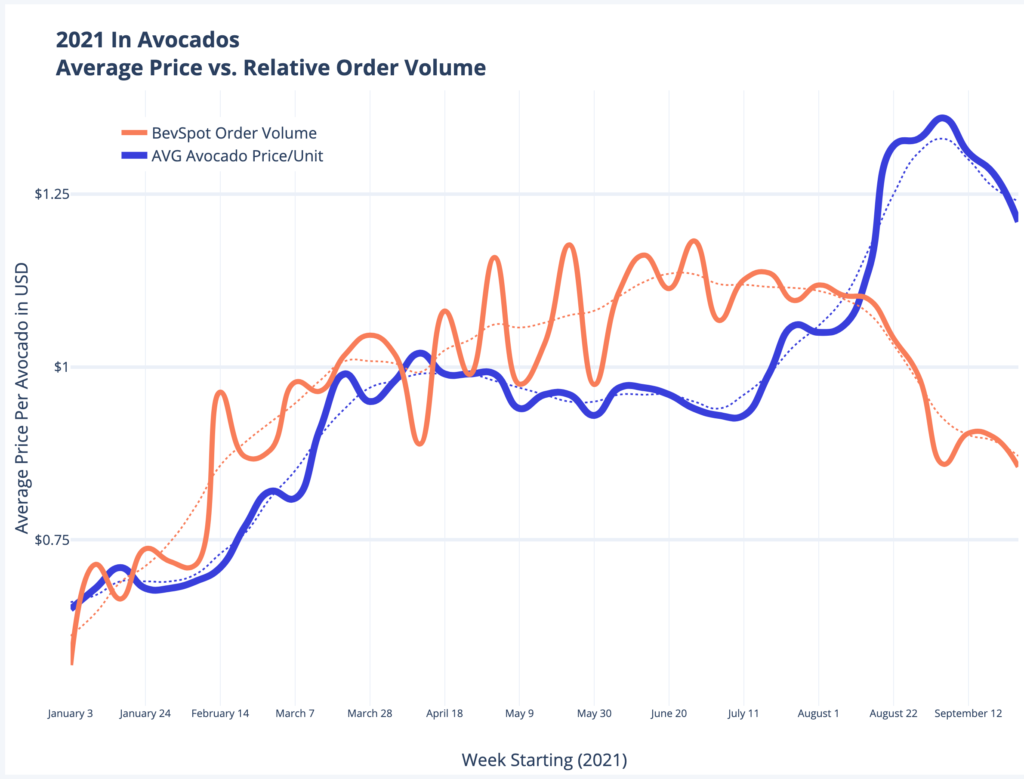
The first thing you’ll notice is a 30% jump in average price per unit paired with a proportional decrease in order volume after August 8th. Fortunately, kitchen managers using BevSpot’s Price Tracker report can keep on top of data like this to maintain profitability.
So, why do avocado prices increase so dramatically throughout August and September?
Avocado Economics
Contrary to popular perception, California is far from the market leader in volume for the U.S. market. According to the California Avocado Commission, Mexico accounts for over 77% of the avocado market, year to date at the time of this deep dive. California trails with about 11%, Peru is just shy of 8.5%, and all other growers total 3.5%.
These top producers have naturally staggered growing seasons, and that helps keep avocados available to U.S. restaurants and consumers year-round.
- Mexico has fluctuating seasons. The primary season falls between October and February. Supply becomes more limited from March to May, with their off-season of June to September gradually dwindling in production.
- California’s peak season ranges from late April through mid-August. There is limited supply produced outside of that season.
- Peru’s season falls between April and June.
This leaves a period during August and September where the top three producers have reduced output leaving a seasonal demand vacuum. High demand with low supply means higher prices.
What does this mean for U.S. restaurants and consumers?
Demand vacuums like this demonstrate the importance of tracking the cost of goods used in your recipes. If your restaurant or bar does not have a good system in place to track fluctuations and drive profitability, please reach out to one of BevSpot’s representatives.
How much did you last pay for avocados? Leave a comment below.
Schedule 15mins to chat with a product specialist
Start a FREE Trial Today! BevSpot offers full product education and account setup for all customers! No card Information needed!
